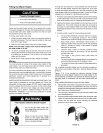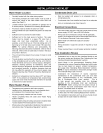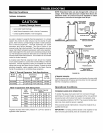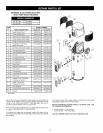
Never use this water heater unless it is completely full of water.
To prevent damage to the tank and heating element, the tank
must be filled with water. The water must flow from the hot water
faucet before turning "ON" power.
A. *Condensation may be seen on pipes in humid weather or
pipe connections may be leaking.
®
®
B. Small amounts of water from the temperature-pressure relief
valve may be due to thermal expansion or high water pressure
in your area.
C. *The temperature-pressure relief valve may be leaking at the
tank fitting.
D. *The element may be leaking at the tank fitting.
6" Maximum
Air Gap
• Before removing any access
panels or servicing the water
heater, make sure the electrical
supply to the water heater is
turned "OFF".
• Failure to do this could result in
death, serious bodily injury, or
property damage.
Read and understand instruction
manual and safety messages
before installing, operating or
servicing this water heater.
Failure to follow instructions and
safety messages could result in
death or serious injury.
Instruction manual must remain
with water heater.
Read this manual first. Then before checking the water heater
make sure the electric supply has been turned "OFF", and never
turn the electric supply "on" before the tank is completely full of
water.
Use this guide to check a"Leaking" water heater. Many suspected
"Leakers" are not leaking tanks. Often the source of the water
can be found and corrected.
If you are not thoroughly familiar with electric codes, the water
heater, and safety practices, contact your local Sears Service
Center to check the water heater.
Improper installation and use may result
in property damage.
• Fill tank with water before operation.
Turn electrical power "OFF", remove access panel and insulation
cap with handle. If leaking around element, follow proper draining
instructions and remove element. Reposition or replace gasket
on element. Place element into opening and tighten securely.
Then follow Filling the Water Heater instructions in the Installation
Instructions section.
E. Water from drain valve may be due to the valve being opened
slightly
F. *The drain valve may be leaking at the tank fitting.
G. Water in the water heater bottom or on the floor may be
from condensation, loose connections or the temperature-
pressure relief valve. DO NOT replace the water heater until
a full inspection of all possible water sources is made and
necessary corrective steps taken.
Check for leaks at the condensate lines and connection points.
If a condensate pump is used check for leaks at the pump. Also
check to see if the pump is not operating or clogged.
Leakage from other appliances, water lines, or ground seepage
should also be checked.
To check where threaded portion enters tank, insert
cotton swab between jacket opening and fitting. If
cotton is wet, follow Draining instructions in the Service
and Adjustment section and then remove fitting. Put
pipe dope or teflon tape on the threads and replace.
Then follow Filling the Water Heater instructions in the
Installation Instructions section.
25


















